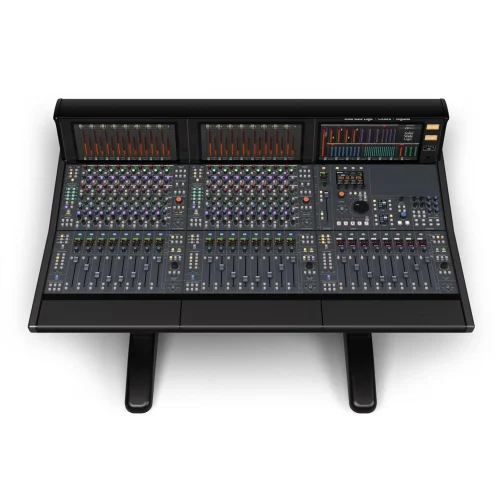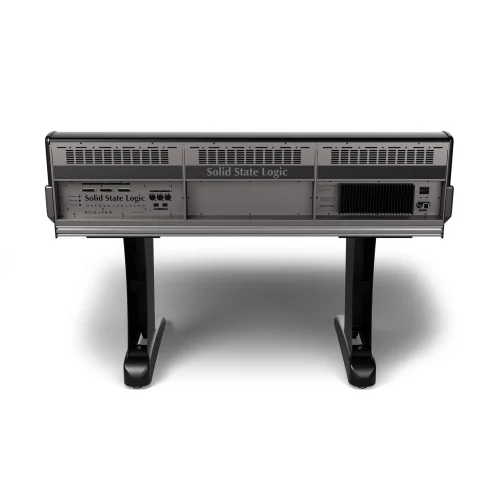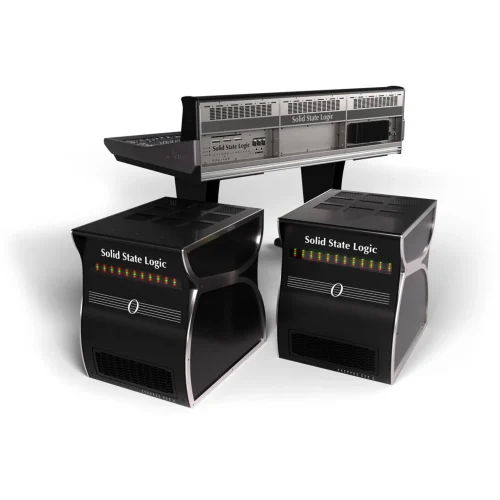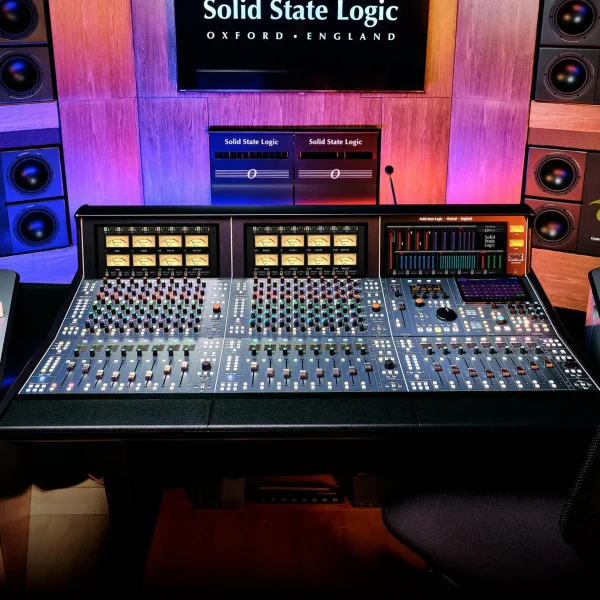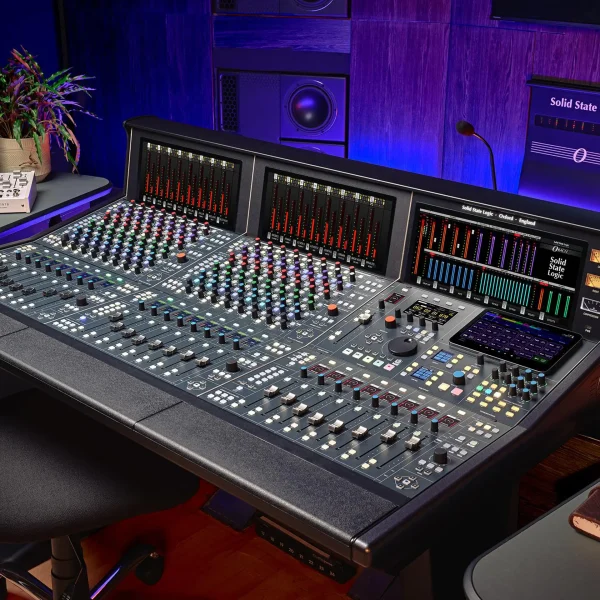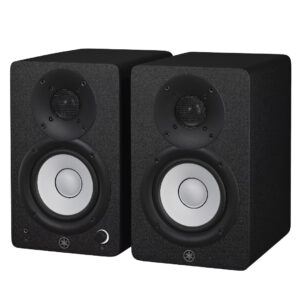Product Description
Solid State Logic Oracle 24-Channel Analog Console
Oracle: The Future of Analog Mixing
In 1979, Solid State Logic revolutionized studio production with the SL 4000E. Equipped with Total Recall, the console was capable of storing and recalling more mix information than any other automation system on the market at the time. This groundbreaking capability — coupled with the board’s high-fidelity sonics — firmly ensconced SSL in the elite echelon of world-class console manufacturers. As advanced as the system was for its day, however, it still required a disruptive process between sessions to load mixes for different projects. But it was a start, marking the beginning of a decades-long quest for an all-analog console that offered instantaneous recall, on-the-fly adaptability, and seamless switching between sessions. Today, that dream is a reality. Solid State Logic revolutionizes analog console technology once again with Oracle.
Impeccable SSL sound, optimized workflows
Equipped with Solid State Logic’s acclaimed analog circuitry and next-generation PureDrive mic preamps with Drive control, Oracle delivers impeccable sound quality. Meanwhile, its flexible channel architecture allows for large-format versatility in a compact, in-line AWS-sized form factor. Under the bonnet, SSL’s cutting-edge ActiveAnalogue technology and Dynamic Automation system supercharge your workflows with instantaneous, seamless, and complete recall of all gain, routing, pan, and processing settings to facilitate instant switching between tracking, overdubbing, and mixing configurations for multiple projects, saving your studio both time and money. Oracle is available with 24 or 48 monaural in-line channels. Both versions feature four stereo Main buses, 16 Track buses, 10 mono/stereo Aux buses, 16 stereo Flex groups, and five stereo Monitor outputs that include bass management.
SuperAnalogue audio with variable drive
Oracle combines harmonic drive technology from SSL’s latest PureDrive preamps, current-driven buses introduced in the Origin console, and multiple saturation options embedded throughout its circuitry. The result is exceptional sonic versatility and industry-leading recall and reset capabilities, all driven by SSL’s cutting-edge ActiveAnalogue technology. Capable of producing pristine, unerring, accurate SuperAnalogue audio, Oracle also offers a palette of analog tones enhanced with variable levels of harmonic saturation, embracing the DNA of classic E, G, and J/K series consoles while taking the SSL sonic signature into the future.
Groundbreaking ActiveAnalogue technology
Representing yet another groundbreaking technology from Solid State Logic, ActiveAnalogue seamlessly integrates the legendary sonics and power of SSL analog processing and summing with ultra-precise settings adjustment and an active control system. This fusion eliminates downtime, disruption, and compromises, delivering superior SSL SuperAnalogue sound and workflow with instantaneous recall capabilities. ActiveAnalogue redefines professional audio production by preserving the distinctive analog warmth and depth that producers, engineers, and their clients demand, while simultaneously removing workflow obstacles that disrupt creativity and impede efficiency.
The Future Analogue channel strip
Oracle sports a traditional in-line design with separate record and monitor paths, independent input gain and output level control, and flexible processing routing. Combining SSL’s advanced analog circuit design with the cherished features of classic SSL desks, Oracle’s stereo/dual-mono Future Analogue channel strip offers a second line-level input and dedicated controls for input gain, filter, aux sends, four-band parametric EQ, and an ultra-premium 100mm motorized fader that can be assigned to either Small or Large Fader paths. A high-resolution Channel Screen directly above the pan pot keeps you status aware with level, pan, and track name information. At the top of each channel strip is SSL’s next-generation PureDrive mic pre with dedicated Drive control, delivering a robust 75dB of gain and a broad range of tonality.
In addition to clear Channel Screen info on the console surface, when Channel Detail View is selected, the associated meter display screen shows a breakout of all the channel parameters and routing, including both Large and Small Fader paths. Detail View displays function interactively with per-bay Navigator controls, providing “scroll and control” access to all parameters, switch functions, and signal routing.
Enhanced 4-band parametric channel EQ
The 242 “Black Knob” E series EQ was SSL’s third console channel equalizer design following the Brown Knob EQ and the Orange Knob 132 EQ. It improved on its predecessors in several ways: it was more powerful, with an additional 6dB of cut and boost; it featured a steeper slope for the highpass filter; and it had the capacity to switch the highpass and lowpass filters out of circuit when not being used. However, beyond the spec sheet improvements, the Black Knob EQ quickly gained notoriety for its open and transparent sound, and engineers were struck by how generously they could apply EQ without adding distortion to a signal, especially when cranking up the bass.
As implemented on each Oracle channel, an enhanced version of SSL’s classic 4-band EQ offers switchable sonic characteristics, allowing you to toggle between constant-Q for the more aggressive sound of the E series and variable-Q for the smoother character of the G series. Both modes provide a dedicated highpass filter, selectable HF and LF Shelf/Bell curves, and fully parametric mid-frequency bands, delivering the coveted tonal signatures of SSL’s renowned EQ design legacy and formidable tone-shaping versatility. The EQs can be flipped between the small and large fader paths per channel, and can also be linked in odd/even channel pairs, providing a single, easy-to-handle control set for stereo sources. Each path has an independent, switchable, and movable Insert point, and is equipped with an independent Direct Output for direct stem or track output to your DAW.
The Center section: your mission control
SSL consoles are known for their comprehensive center sections. Oracle carries on this tradition with high-resolution encoders and displays that provide tactile control and visual feedback, putting you in complete command of every session. Detail Views encompass not only channel processing but also all processing within the Center section. They are displayed when a Center section Detail View is activated. During this display, the Main meters are reduced to allow focus on the console’s output buses.
Bus+: your one-stop shop for analog character
The center section compressor from SSL’s G series console has achieved must-have status among audio professionals for its uncanny ability to glue together a mix in a distinctly vital and musical way. Oracle vastly expands on this concept with the Bus+. Constituting a modern update on this essential tool, the Bus+ incorporates several coveted SSL analog processors into one easy-to-use module, delivering the coveted glue and punch of the classic mix bus compressor and so much more, all in one easy-to-use processor. Offering four modes of operation, Low THD, Feed-Back, and “4K” (4000 series console legacy) Saturation modes, plus coveted SSL analog processing such as Dynamic EQ, Transient Expander, and more, the Bus+ is your one-stop shop for analog character. The Bus+ adds outstanding flexibility to Oracle’s sonic capabilities and is fully recallable, courtesy of ActiveAnalogue technology.
Comprehensive bus network
Oracle offers a comprehensive set of Track and Aux buses, each featuring unique flexibility options. Its 10 Aux Buses may be independently configured as either mono or stereo, while 16 Track buses can be routed from both large or small fader channel paths. Routing can be mono, or follow the channel to mix bus panning in odd/even track bus pairs to create stereo group mixes.
Stereo group inputs
Oracle is spec’d with eight fader-controlled Stereo Group inputs that can also pick up the 16 Track buses in pairs. Equipped with an integrated width/image control and a switched insert, each Stereo Group input can send to any of the Track, Aux, or Mix buses, as well as a dedicated Direct Output. Mid-side (M-S) encoding prior to the Stereo Group Insert facilitates independent processing of mid or side signals, while a selectable post-insert-return M-S Decode circuit is onboard to decode M-S signals into stereo group channels. The Stereo Group Inputs can each route to any of Oracle’s four main Mix buses, Track buses, or any of the 10 Aux buses.
Control room monitoring and foldback
Oracle’s monitoring system upholds the legacy of previous SSL consoles, which provided Main plus four alternative Stereo Monitor sections. The fourth Alt monitor can be configured as a subwoofer/LFE output with bass management capabilities. Remote Monitor Control functionalities grant access to control of 3rd-party processing such as Dolby Atmos, enabling the creation of a hybrid monitoring system optimized for immersive formats. The Oracle system comprises three independent Foldback feeds, a surface-mounted headphone output, and four stereo external source inputs, including a console surface stereo input for direct injection (DI) of an instrument or connecting a third-party Bluetooth receiver.
Sophisticated metering system
Oracle is designed to handle the complexities of modern recording in all its myriad facets, and its sophisticated metering system leverages modern display technology to keep you status savvy at all times. The console’s high-resolution displays located above each bay logically convey Channel EQ, Insert, and Filter configuration; Small and Large Fader routing and level metering, Bus routing, and full track names are available on the switchable classic VU or plasma-style metering, both of which are modeled on the original 4000 series console metering options.
Ready for the most demanding projects
With up to 112 inputs at mixdown (for the 48-channel configuration), Oracle can handle even the most demanding projects. Monster mix sessions are easily accommodated with Oracle’s combination of mix paths from both record and monitor faders, independent path inserts, and direct outputs, as well as multiple parallel sub and stem mixes from the four stereo Main buses, 10 Aux buses, 16 Track buses, and the 24-channel Oracle processing rack. This all adds up to 48 mix paths, comprising 16 stereo sub-mixes and a primary stereo bus, all controlled by faders. An additional rack of 24 in-line channels doubles the channel processing capacity, enabling a total of 96 mix paths.
Oracle Rack
The Oracle Rack, which houses all analog circuitry, is a key element of Oracle’s refined architecture. A typical Oracle system will have two processing racks, which can be located in your control room, adjacent to or away from the console, or even in a separate machine room. One rack handles the center section processing; the second is dedicated to the channels. A system might have one or two channel racks, depending on your console’s channel specification, to create a system of two or three racks. The racks are actively cooled, but maintain an acoustic noise floor below NR25.
Advanced DAW control
Since Solid State Logic’s AWS series, the company’s console-integrated DAW control has allowed engineers to instantly shift from the analog world to hybrid and fully in-the-box mixing, while benefiting from the efficiencies and sonic richness of a proper analog mixing console. With a single button press, you can switch Oracle’s surface faders between Analogue Processing and DAW Control modes using the Focus key. This function can be executed on a per-bay basis, providing a convenient way to deploy Analogue Processing and DAW Control modes in adjacent console bays.
Immersive-format compatibility
SSL plans to extend Oracle’s remote-control capability to 3rd-party immersive monitoring solutions such as Dolby Atmos Renderer. In practice, this mutes the console’s analog stereo monitoring and passes surface monitoring control messages to the immersive-format renderer being used, opening up Oracle’s superior analog processing to the gamut of current and future immersive music and film sound formats.
O-Control
The O-Control application suite is a cross-platform (macOS and Windows) suite of control, configuration, and session management applications for Oracle. The apps can run standalone/offline and in this way can be used as tools to create, edit, and update project information for Oracle consoles. They can also run in tandem with the console to assist with session configuration and management tasks such as saving and loading presets, creating snapshots, and logging project information. Running under O-Control is the O-Setup app, which manages the console settings, and O-Session, which manages the saving and loading of projects, presets, and snapshots, as well as the control and inspection of console processing sections. Lastly, O-View shows an overview of the console at its current state.
Templates get you up and running fast
A byproduct of SSL’s advanced ActiveAnalogue technology is Oracle’s ability to create project Templates that recall all settings and routing across the board. Every producer and engineer has a particular work methodology, and Oracle’s Templates serve as convenient starting points for specific recording and mixing applications. In tandem with the O-Control application, Oracle makes console setup quick and easy, allowing your sessions to get underway faster than ever before!
The Solid State Logic legacy
Since its founding by Colin Sanders in 1969, Solid State Logic has followed a design philosophy that prioritizes the needs of artists, engineers, and producers. The company’s products facilitate creativity by removing technical impediments and streamlining workflows. Firmly ensconced in the pantheon of pro audio greats, SSL helped shape the history of pro audio. Impressively, it continues to innovate, bringing its uncompromising quality and signature sonics to a new generation of artists and creators. Marshall Music is proud to offer you SSL’s pedigreed line of consoles, signal processors, and audio interfaces.
Solid State Logic Oracle Features:
- Compact large-format in-line analog mixing console
- Available in 24- and 48-channel configurations
- Flexible channel architecture with up to 112 inputs at mixdown
- Advanced SSL circuitry, controlled by ActiveAnalogue technology
- Next-gen PureDrive preamps with Drive control
- 4 Stereo Mix buses, 16 Track buses, 10 Aux buses, 16 Stereo Flex Groups
- Enhanced SSL 4-band parametric EQ with switchable E/G Series curves
- Integrated Bus+ and Dynamic EQ processors
- SSL Dynamic Automation system; ultra-premium 100mm motorized faders
- Complete recall of all gain, routing, pan, and processing settings
- Instant switching between tracking, overdubbing, and mixing configurations
- Small and Large Fader paths with assignable EQ and Insert points
- Versatile monitoring with multiple stereo and immersive mixing options
- Informative VU or Plasma-style metering with dynamic Detail View
- Advanced DAW control with SSL 360 integration
- O-Control app for offline session preparation and console configuration
- 13U, 19-in. racks house all analog circuity
Learn more about Solid State Logic
View more Solid State Logic at OneStopMusic


